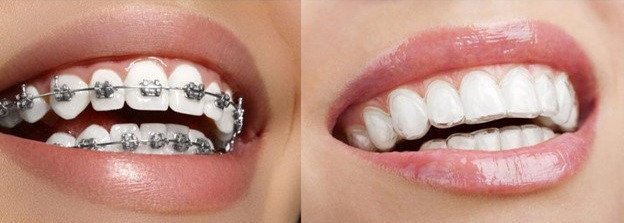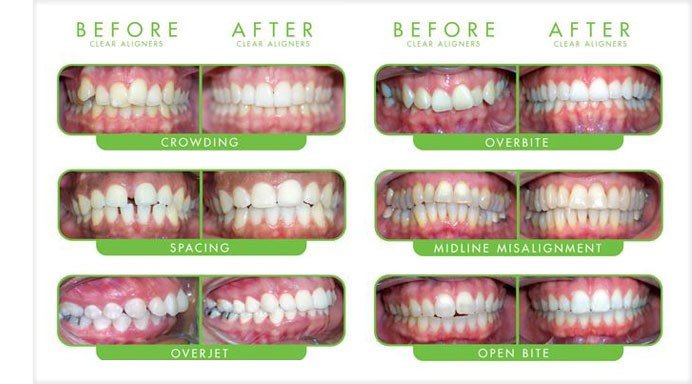
Our smile makes up a major part of our facial appearance. Crooked, misaligned teeth are one of the top complaints of people who come in a dental clinic. But the good part is that it is 100% treatable with orthodontic treatment. Clear Aligners are the most recent advances made in the orthodontic society for achieving a perfect smile and have surpassed traditional metal braces.
Clear aligners are orthodontic devices made of polyurethane plastic trays that are custom-made for each patient for alignment and occlusal adjustment of teeth. These aligners are made in sets, each to be worn for a period of 2 weeks. A 3D oral scan is taken of the whole mouth- the upper and the lower jaw and the aligners are then made based on the scan.

Traditional metal braces use brackets and wires made of stainless steel or other materials. These wires can often be harsh on our soft tissues- gums, lips and cheeks causing discomfort to the patient. On the other hand, clear aligners, made of soft plastic, cause no such discomfort.
Clear aligners can be used to treat mild to moderate crowding or spacing whereas traditional metal braces are preferred for cases of severe crowding or spacing. Clear aligners are aesthetically more pleasing and can be worn throughout the day by the patient in public and social gatherings since they are almost invisible. On the contrary, traditional metallic braces, which are very much visible can be an unpleasant reason for embarrassment.
The greatest benefit of clear aligners lies in the patient’s ability to maintain good oral hygiene during an ongoing orthodontic treatment which isn’t always the case with the use of traditional metal braces that are fixed onto the teeth by the orthodontist. Clear aligners are removed by the patient while eating meals and during brushing and flossing, thereby making oral hygiene maintenance an easy task. Since the use of clear aligners facilitates oral hygiene, it also improves the periodontal status and causes a decrease in plaque levels, gingival inflammation, bleeding upon probing, and pocket depth. Fixed appliances and wires make plaque control difficult and have adverse effects on periodontal tissues, making orthodontic treatment a predisposing factor for periodontal diseases.
Another reason for the preference for aligners is the ease of use and the decreased number of visits to your orthodontist. There is no impact on your diet when you take out your aligners to eat. You'll be able to continue eating the things you enjoy. When wearing braces, some foods might be challenging or uncomfortable to consume. Additionally, they may break, delaying therapy and necessitating additional visits for repairs.

An oral exam is conducted on the first visit which is then followed by a 3D oral scan of the whole mouth. Based on the scan, several sets of customized fitted trays are made. Each set of aligners is worn for a period of two weeks after which the patient moves on to the next one. With each aligner, there is about 0.25-0.33 millimeters of tooth movement.
Based on the requirements for arch alignment, forces are produced for tipping, retraction, protraction or minor rotation of teeth. In some cases, temporary anchorage devices can also be used. Aligners produce light continuous orthodontic forces throughout the day. On the first and second days, the pressure exerted by the aligners will be experienced more as compared to the subsequent days wherein the aligners will start loosening up due to the alignment of teeth according to the tray.
Patient compliance is of utmost importance during the whole treatment. The aligners should only be removed during brushing, flossing, and eating meals. The aligners should be worn for at least 22 hours a day. The time for the whole treatment procedure will vary on the number of trays required for the alignment and patient compliance. After the completion of treatment with aligners, the patient is then required to use retainers for a period of 6 months to one year to prevent any relapse.
The cost of aligners varies on the severity of malocclusion (irregularity of teeth). The best teeth aligners used at Cosmetica India start at just ₹24,995.
© 2023 Cosmetica India. All Right Reserved. Designed & Developed by Dart Digital Agency